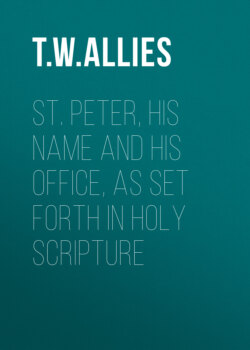| Different sorts of proof.—1. The principal here used, and the subsidiary.—Their |
| joint force | 246 |
| Hence, I. The nature of the answer required to it.—2. The proof, if unanswered, |
| demonstrates the Primacy to be revealed | 247 |
| 3. Enquiry into the certitude of the proof used | 248 |
| I. Force of the proof in itself and absolutely.—Two conditions requisite, |
| and here found, authenticity of the documents, and clearness of their |
| evidence.—Number and harmony of scriptural testimonies to the Primacy | 249 |
| The parallel of Julius Cæsar | 250 |
| Collateral proof, supporting that of the holy Scriptures, so that the whole |
| consists in the harmony of these four:—1. Scriptural documents.— |
| 2. Ancient witnesses.—3. Analogy.—4. Facts of Christian history, in fourteen |
| distinct classes | 251 |
| Prodigious force of this compound proof | 256 |
| No counter religious system producible by Greek, Anglican, or pure Protestant, |
| but mere negation and objection | 257 |
| II. Force of the proof comparatively with other doctrines: comparison |
| with the texts on which Anglicans, Lutherans, and Calvinists severally |
| rely | 259 |
| Retort that all but Catholics are opposed to our interpretation; answer, |
| that from Catholics alone we are to gather the truth | 260 |
| Yet all protestants not agreed in opposing our interpretation and reasons |
| why their opposition is of little moment | 261 |
| Compare, likewise, opposition to the Church in the fourth, fifth, and |
| sixth centuries | 264 |
| And again the conduct of Lutherans and Anglicans in maintaining their |
| own distinctive texts.—But what, then, are the true criteria of documentary |
| evidence? They are four:— |
| Internal {and immediate {4. Verbal. |
| { {2. Real. |
| {and remote 3. Analogical. |
| External 4. Agreement of witnesses | 265 |
| 1. Comparison carried through verbal criterion, between the texts alleged |
| by us, and those of Lutherans, Anglicans, and Calvinists | 266 |
| 2. And through the real criterion, or that of the subject matter, greater |
| in the proofs for Peter's prerogatives than in those for the real presence, |
| or the Divinity of Christ, on account of the difficulty of grasping |
| the object in the latter cases | 267 |
| As to the superiority of bishops over presbyters, the proof severed from |
| that of the Primacy sinks into nothing: considered with it, it is of the |
| same character, but weaker | 268 |
| Accordingly, the criterion from the subject matter is stronger for Peter's |
| Primacy, than for the superiority of bishops over presbyters, for the |
| real presence, and for the Divinity of Christ.—Sum of both these criteria, |
| verbal and real, in favour of Peter's Primacy, over these three |
| doctrines | 270 |
| Appeal hence arising to Lutherans, Anglicans, and Calvinists.—Comparison |
| with the inferior evidence for other received doctrines | 271 |
| 3. The third criterion of analogy: force of this in favour of Peter's Primacy |
| from three heads:—1. The divine institution of bishops.—2. The |
| unity of the Church.—3. The Catholicity of the Church | 272 |
| 4. Fourth criterion of witnesses.—Immense force of this criterion, both |
| as stated by the fathers, and shewn by Protestants in their own conduct | 274 |
| Witnesses unanimous in favour of the Primacy | 277 |
